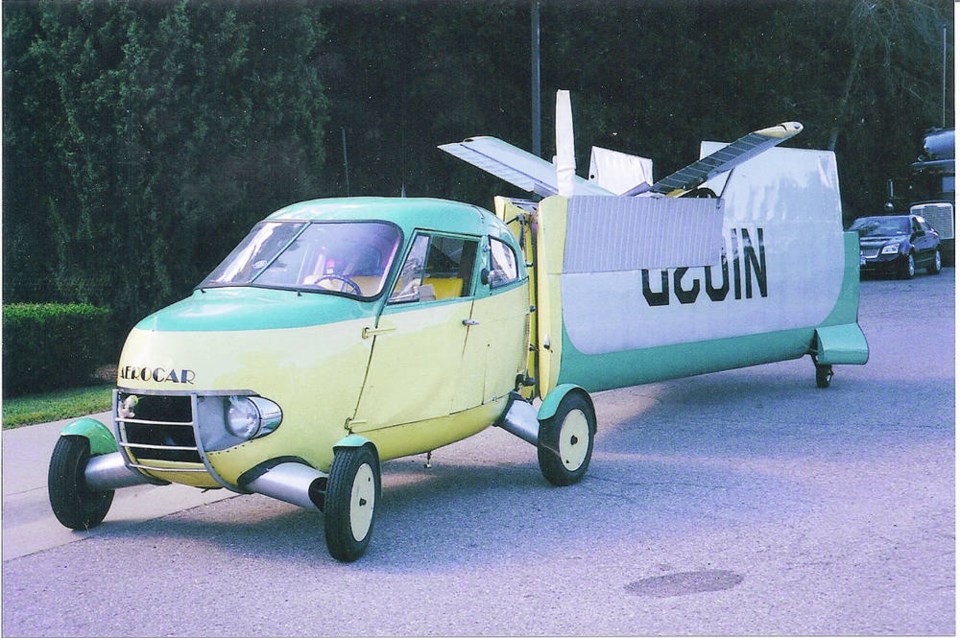The patenting of the first car in 1886 by Germany’s Karl Benz was a revelation. It promised personal freedom of travel without schedules or the limitations of animal or human power. This new invention was soon joined by the airplane from the Wright Brothers of Ohio, U.S.A. in 1903. Flush with man’s apparently unstoppable ingenuity visionaries soon began dreaming of combining the two in a dual purpose air-land machine.
As the airplane and car matured the attempts began materializing. Aviation pioneer Glenn Curtiss’s 1917 Autoplane, Frenchman Rene Tampier’s 1921 Tampier Biplane, James Ray’s 1935 Pitcairn Autogiro and Waldo Waterman’s 1937 Studebaker powered Waterman Arrowbile pursued the dream.
William Stout, designer of the Ford Trimotor airplane and 1930s Stout Scarab minivan precursor built several Skycars.
In 1946 Robert Fulton Jr., flew his Airphibian car/plane and received United States Civil Aviation Administration (CAA) certification. Convair engineer Ted Hall was another 1930s-40s car/plane builder.
The idea continues to be pursued by more recent inventors. Some grafted wings onto small cars like the Ford Pinto or Lotus Elise. Most could fly but all involved compromises. A few received CAA or Federal Aviation Administration certification but none was produced commercially.
The man who came closest to a commercially successful flying car success was Moulton “Molt” Taylor, an aeronautical engineer, pilot and guided missile researcher in Seaview, Washington. Taylor became convinced the flying car was viable in 1946 after meeting Airphibian inventor Robert Fulton Jr.
Taylor began designing his own flying car, incorporated his Aerocar International Co. in 1947 and By 1949 he had built Aerocar I. Whereas Fulton’s Airphibian had a fixed wing and tail unit that didn’t accompany the vehicle during ground travel, all Taylor’s components could travel together at all times.
His two passenger unit construction Aerocar’s wings detached and folded back against the detachable tail. This wing-tail unit had small wheels at the inner ends of the wings, making it function as a trailer when the wings were folded.
This trailer was 4,724 mm (15.5 ft) long and 2,438 mm (8 ft) high and could be towed by the Aerocar’s car component. Claimed conversion time by one person was five minutes.
The Aerocar’s 135 horsepower, horizontally opposed four cylinder Lycoming aircraft engine was behind the cabin. Wingspan was 10.36 m (34 ft) and overall length 6.55 m (21.5 ft). Empty weight was 590 kg (1,300 lb) and gross weight 953 kg (2,100 lb).
Taylor favoured the “pusher” design via a single rear propeller behind the three-part empennage. Power reached the propeller though a driveshaft that connected to the power takeoff hidden behind the licence plate. Top airspeed was 180 km/h (112 mph).
The Aerocar car’s four cycle-fendered 12-inch wheels acted as the plane’s landing gear. It was driven through the front wheels by the same engine, reduced to 40 horsepower for ground use.
Suspension was initially coil springs, later switched to torsion bars. Brakes were powerful B.F. Goodrich aircraft types on the rear wheels. Wheelbase was 2,031 mm (80 in.) and overall length 3,150 mm (124 in.). Maximum ground speed was 97 km/h (60 mph).
Taylor received CAA Aerocar certification in 1956 and tried unsuccessfully to get into production through several companies. Ford Motor Co. assessed it in the early 1970s but concluded the development cost and uncertain future were too risky.
There were at least five Aerocars (some reports say seven) built between 1949 and about 1967, including four Aerocar I’s, one Aerocar II and one Aerocar III that was a rebuilt Aerocar 1. All were similar except Aerocar III, which was the Aerocar I that Taylor bought back in damaged condition from a customer and rebuilt with a more modern, aerodynamic cabin.
Amazingly, all of the Aerocars still exist, most in aircraft museums around the U.S. The 1956 Aerocar II pictured appeared at the annual 2008 Meadow Brook Concours d’Elegance at Michigan’s Oakland University.
It was previously owned by television personality Bob Cummings and appeared on his show. It now has a new owner, and was airworthy when it was at Oakland.
Moulton Taylor died in 1995 at age 83. His lack of success in guiding the Aerocar into production was no reflection on his technical abilities. He still believed in the concept and felt that it didn’t need to be compromised either as an air or land vehicle.
Taylor was convinced that his idea was just ahead of its time, although he did work in a less complicated era. Designing and building a car/plane that would meet today’s safety/emissions/economy regulations for both a car and plane with the many government agencies involved would be a formidable undertaking. Using an existing car such as the Lotus would facilitate this somewhat.
Although some claim they are imminent, the successful commercially viable flying car still seems uncertain.



